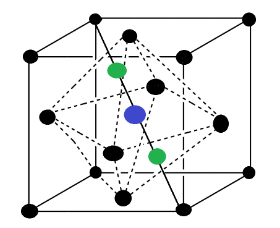
Answer
407.7k+ views
Hint: A solid crystal is arranged in a three-dimensional order where each atom which is considered as a sphere is packed voids are formed. Two types of voids are formed, tetrahedral and octahedral. The tetrahedral voids are formed when four atoms are arranged in tetrahedral like shape, the void or we can say the space between them is tetrahedral void while when atoms are arranged in octahedral order they form an octahedral void.
Complete step-by-step answer:
A unit cell is a small portion of crystal lattice, like as we have in a rhombic cube. In a rhombic cube one small colored portion can be considered as a unit cell. So there are some particular modes in which atoms are arranged in a unit cell, SCC BCC and FCC. In a simple cubic cell eight atoms are present at the corners while in the other two there are some extra atoms. In BCC eight atoms are at the corner and one atom is present at the center. In FCC there are eight atoms at the corners and one at each face.

In the above figure the blue color voids are octahedral voids while the green color are tetrahedral voids. Sometimes FCC is also called a closed packed structure. There are two types of voids present at two different positions. It was seen that in one unit cell of FCC type, one octahedral void is present at the body-center while two tetrahedral are present at the body diagonal. So we can say that two tetrahedral voids are present on each body diagonal of FCC at a distance of $\dfrac{{\sqrt 3 a}}{4}$ , thus
Therefore, the correct option is (C).
Note: The type of arrangement will decide the number of voids in a unit cell. As we have FCC face centered unit cells. In this unit cell we have overall four atoms, it means there will be four octahedral voids while the tetrahedral voids are doubled in number. In case of BCC there is only one void which is cubical void.
Complete step-by-step answer:
A unit cell is a small portion of crystal lattice, like as we have in a rhombic cube. In a rhombic cube one small colored portion can be considered as a unit cell. So there are some particular modes in which atoms are arranged in a unit cell, SCC BCC and FCC. In a simple cubic cell eight atoms are present at the corners while in the other two there are some extra atoms. In BCC eight atoms are at the corner and one atom is present at the center. In FCC there are eight atoms at the corners and one at each face.

In the above figure the blue color voids are octahedral voids while the green color are tetrahedral voids. Sometimes FCC is also called a closed packed structure. There are two types of voids present at two different positions. It was seen that in one unit cell of FCC type, one octahedral void is present at the body-center while two tetrahedral are present at the body diagonal. So we can say that two tetrahedral voids are present on each body diagonal of FCC at a distance of $\dfrac{{\sqrt 3 a}}{4}$ , thus
Therefore, the correct option is (C).
Note: The type of arrangement will decide the number of voids in a unit cell. As we have FCC face centered unit cells. In this unit cell we have overall four atoms, it means there will be four octahedral voids while the tetrahedral voids are doubled in number. In case of BCC there is only one void which is cubical void.
Recently Updated Pages
what is the correct chronological order of the following class 10 social science CBSE

Which of the following was not the actual cause for class 10 social science CBSE

Which of the following statements is not correct A class 10 social science CBSE

Which of the following leaders was not present in the class 10 social science CBSE

Garampani Sanctuary is located at A Diphu Assam B Gangtok class 10 social science CBSE

Which one of the following places is not covered by class 10 social science CBSE

Trending doubts
Harsha Charita was written by A Kalidasa B Vishakhadatta class 7 social science CBSE

Which are the Top 10 Largest Countries of the World?

Banabhatta wrote Harshavardhanas biography What is class 6 social science CBSE

Difference Between Plant Cell and Animal Cell

Fill the blanks with the suitable prepositions 1 The class 9 english CBSE

How do you graph the function fx 4x class 9 maths CBSE

The Equation xxx + 2 is Satisfied when x is Equal to Class 10 Maths

One Metric ton is equal to kg A 10000 B 1000 C 100 class 11 physics CBSE

Why is there a time difference of about 5 hours between class 10 social science CBSE



